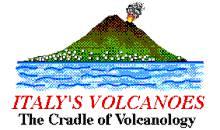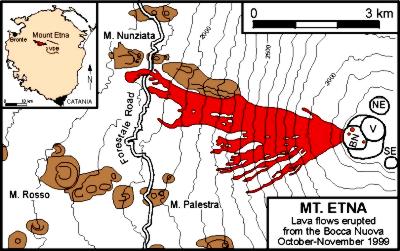|
NEW:
Excursions to the Etna area, Revised map of the lava flows emitted from the Bocca Nuova during October-November 1999, based on photos taken from various locations. Main vents of the Bocca Nova (BN) are shown as orange colored dots. The other summit craters are the Northeast Crater (NE), Voragine (V) and Southeast Crater (SE). The inset at upper left shows the entire Etna area with the location of the new lavas and the towns of Bronte and Catania. VDB in the inset is Valle del Bove. For previously unpublished photos of the summit activity of September-November 1999, visit this page. For those of you who missed the Etna telecamera (please note that I am not the right person to ask about technical details of the telecamera), visit this site: "Sistema Poseidon" (in Italian) and go to "Etna live-cam "
12
January 2000 update.
The following information is summarized from reports in the local
newspapers "La Sicilia"
and "Giornale di Sicilia".
A swarm of 22 small earthquakes (including two of a magnitude of 3
or more on the Richter scale) has occurred on 11 January on the E
flank of Etna. Some of the events were distinctly felt by the population
of various towns and villages, such as Fornazzo, Sant'Alfio, Trecastagni,
Zafferana, Giarre and Riposto. Very minor damage to buildings was
noted in Riposto and Sant'Alfio, but no injuries were reported. The
earthquakes occurred between 0734 and 1946 h (local time=GMT+1), and
the epicentral area was located about 3 km north of Fornazzo with
hypocenters located at a depth of about 7 km. This is the second significant
earthquake swarm in the Etna area in less than one month; however,
it is probably related to tectonic movements in the "Timpe"
fault system on the E flank of Etna, an area of very frequent seismic
activity whose relationship with magma movement within the volcano
remains largely mysterious to the present day. 8 January 2000 update. Eruptive activity has continued at the Bocca Nuova during the past two weeks. It seems that magma has returned to relatively high levels in both the NW and SE vents in the former crater which was filled to overflow in October-November 1999, and Strombolian explosions frequently have ejected incandescent lava fragments high above the vents. Etna greeted the new millennium with a display of Strombolian bursts from the Bocca Nuova at about 02:00 h on the morning of 1 January, which was well visible in towns around the volcano. Bombs were observed to fall outside the crater on 2 January during a visit by Claude Grandpey of the "Association Volcanologique Européenne" (L.A.V.E). On the morning of 7 January the Strombolian activity was accompanied by frequent emissions of ash, and similar emissions occurred on 8 January; at night a fluctuating glow was visible at both vents in the Bocca Nuova. All this suggests that the activity is at significanly higher levels than in the past two months; yet it is not clear whether it will culminate in a manner as spectacular as it did last autumn, and when it will do so. 27
December
1999 update.
During the past two weeks ash emissions from the Bocca Nuova (probably
from the vent in its southeastern part) have become more and more
frequent, and on the evening of 23 December Giuseppe Scarpinati (Italian
correspondent of the Paris-based "Association Volcanologique
Européenne", L.A.V.E.) observed continuous incandescence
in the summit area which was visible with the naked eye. Scarpinati
lives in Acireale, about 20 km SE of Etna.
The next morning, near continuous puffs of ash-laden gas rose from
the SE vent of the Bocca Nuova, forming a plume that was driven southwards
by the wind. Local press sources report that due to the ash falls
on the S flank skiing has become impossible, although much snow had
fallen on the volcano recenty. A series of other web pages covering the October-November eruptions of the Bocca Nuova have recently posted; these contain photos and movie clips of some of the most spectacular moments of that period. Photos of the eruptive activity, 26-31 October 1999, by Tom Pfeiffer (University of Arhus, Denmark) Photos by Marco Fulle, 17-23 October 1999, at Stromboli On-line - Marco at his best Very impressive video clips, taken by Roberto Carniel on 17-23 October 1999, at Stromboli On-line Photos by Juerg Alean, of 1 November 1999, at Stromboli On-line Video clips, taken by Juerg Alean on 1 November 1999, at Stromboli On-line A page by Charles Rivière, France, with many photos of the summer and autumn of 1999 (in French)
Page set up on 27 May 1997, last modified on 12 January 2000 |
||

